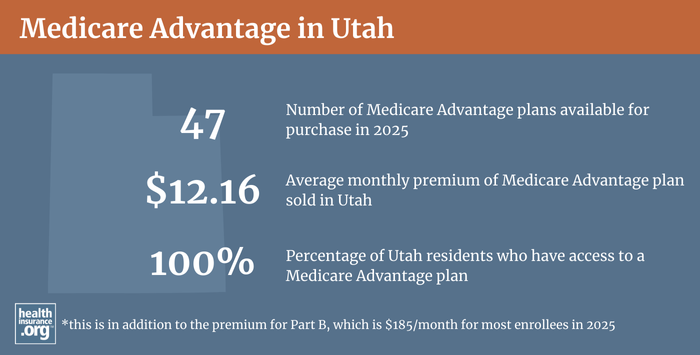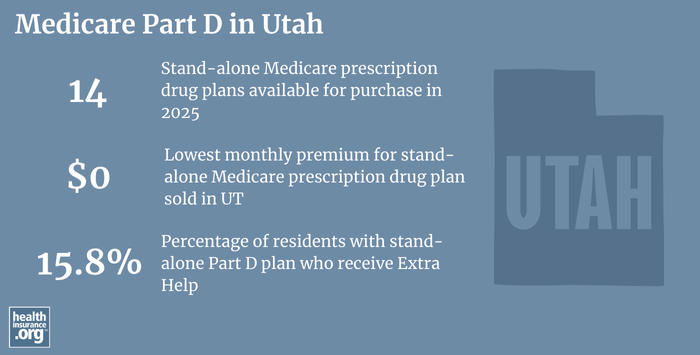Medicare in Utah

Utah does not require Medigap insurers to offer plans to beneficiaries under age 65, and only three companies do so voluntarily
Key takeaways
- Less than 13% of Utah residents are enrolled in Medicare.
- 49% of Utah Medicare beneficiaries have Medicare Advantage plans;1 plan availability ranges from fewer than 10 to almost 30 plans, depending on the county.2
- 36 insurers offer Medigap plans in Utah,3 and nearly 86,000 people are enrolled.4 Insurers are not required to offer Medigap plans to people under age 65, and only two do so.3
- Premiums for stand-alone Part D prescription drug plans in Utah start at $5.10 per month in 2023.5

Utah Medicare enrollment
As of September 2024, there were 465,223 people with Medicare in Utah.6 That’s about 12% of the state’s population.7
Medicare eligibility is also triggered once a person has been receiving disability benefits for 24 months, or is diagnosed with Amyotrophic Lateral Sclerosis or End-Stage Renal Disease. Nationwide, about 11% of all Medicare beneficiaries are under 65 and eligible due to disability.8 In Utah, about 9% of Medicare beneficiaries are eligible because they’re disabled.6
Medicare options
In most areas of the country, Medicare beneficiaries can choose Original Medicare or a Medicare Advantage plan. Medicare Advantage plans are available in most, but not all counties across the United States; all areas of Utah have Medicare Advantage plans available as of 2025.9
Original Medicare includes Part A (which helps pay for inpatient stays, like at a hospital, skilled nursing facility, or hospice center) and Part B (which helps pay for outpatient care like a doctor appointment or a preventive healthcare service, such as vaccinations).
Medicare Advantage plans are administered by private insurance companies, and all of the benefits of Original Medicare are covered. In addition, Medicare Advantage plans typically have offered additional benefits, such as prescription drug, dental, and vision coverage. However, healthcare provider networks may be limited with Medicare Advantage, and out-of-pocket costs are typically higher than an individual would have if they opted for Original Medicare plus a Medigap plan.10 In short, there are pros and cons either way, and no one-size-fits-all solution.
Learn about Medicare plan options in Utah by contacting a licensed agent.



Explore our other comprehensive guides to coverage in Utah

We’ve created this guide to help you understand the Utah health insurance options available to you and your family, and to help you select the coverage that will best fit your needs and budget.


Hoping to improve your smile? Dental insurance may be a smart addition to your health coverage. Our guide explores dental coverage options in Utah.


Learn about Utah’s Medicaid expansion, the state’s Medicaid enrollment and Medicaid eligibility.


Short-term health plans provide temporary health insurance for consumers who may find themselves without comprehensive coverage. Learn more about short-term plan availability in Utah.

Frequently asked questions about Medicare in Utah
What is Medicare Advantage?
In 2018, 36% of people with Medicare in Utah were enrolled in Medicare Advantage plans, the other 64% of Utah’s Medicare beneficiaries had opted for Original Medicare instead.11 But as is the case nationwide, Medicare Advantage plans are becoming increasingly popular: As of March 2023, Medicare Advantage plans covered almost half of the state’s total Medicare population.1 (Utah has tracked very close to the national average, which stood at about 48% as of March 2023)12
Medicare Advantage plans are available throughout Utah in 2023, but quite a few counties have fewer than 5 plans available, while others have almost 30.2
Medicare beneficiaries can switch between Medicare Advantage plans and Original Medicare (and can add or drop a Medicare Part D prescription drug plan) during the Medicare Annual Enrollment Period, which runs from October 15 to December 7 each year. Medicare Advantage enrollees also have the option to switch to a different Medicare Advantage plan or to Original Medicare during the Medicare Advantage Open Enrollment Period, which runs from January 1 to March 31.13
- Read our guide to Medicare’s open enrollment.
- Understand the difference between Medigap, Medicare Advantage, and Medicare Part D.

What is Medigap?
Nationwide, over 80% of Original Medicare beneficiaries have supplemental coverage provided by an employer-sponsored plan or Medicaid.14 But for those who don’t, Medigap plans (also known as Medicare supplement insurance plans) are designed to pay some or all of the out-of-pocket costs (deductibles and coinsurance) that enrollees would otherwise have to pay themselves.15 Since Original Medicare does not include a cap on out-of-pocket costs, most enrollees maintain some form of supplemental coverage, and Medigap plans are one option.
Although Medigap plans are sold by private insurers, the plans are standardized under federal rules. There are ten different plan designs (differentiated by letters, A through N), and the benefits offered by a particular plan (Plan A, Plan G, etc.) do not differ from one insurer to another. This allows consumers to compare plans based on price and less tangible things like customer service, since the benefits themselves are uniform.
There are 36 insurers currently offering Medigap plans in Utah3 (and up to 110 insurers with active policies, not all of which are still marketed to new enrollees).16 And according to an America’s Health Insurance Plans (AHIP) analysis, there were 85,670 people enrolled in Medigap plans in Utah in 2020.4
Unlike other private Medicare plan coverage (Medicare Advantage plans and Medicare Part D prescription drug plans), there is no annual open enrollment window for Medigap plans. Instead, federal rules provide a one-time six-month window when Medigap coverage is guaranteed-issue. This window starts when a person is at least 65 and enrolled in Medicare Part B (you have to be enrolled in both Medicare Part A and Medicare Part B to buy a Medigap plan).15
But although people under the age of 65 can enroll in Medicare if they’re disabled and have been receiving disability benefits for at least two years, federal rules do not guarantee access to Medigap plans for people who are under 65. The majority of the states have implemented rules to ensure that disabled Medicare beneficiaries have at least some access to Medigap plans, but Utah is not among them. In late 2021, the Utah Insurance Department submitted a recommendation to the legislature that the state should enact legislation to require Medigap insurers to offer their policies to disabled Medicare beneficiaries. But the legislature had not taken action on this by the spring of 2023.
Most of the Medigap insurers in Utah do not offer Medigap plans to people under the age of 65 who are eligible for Medicare due to a disability, and only two do so.3
The Utah Insurance Department reported that as of 2022, only 1.3% of all Medigap enrollees in Utah were under the age of 65.17 The Insurance Department’s report notes that the low enrollment among people under age 65 is likely due to the fact that Utah does not require Medigap insurers to make their products available to people under the age of 65.
Medicare Advantage plans are available to anyone eligible for Medicare, and the prices are not higher for people under 65. So people under the age of 65 in Utah who are eligible for Medicare can choose a Medicare Advantage plan in order to have a cap on out-of-pocket costs. But again, Medicare Advantage plans may have limited provider networks, which is an important consideration for people with serious health issues.
A person enrolled in Medicare prior to age 65 as a result of a disability will have the same Medigap Open Enrollment Period as other Medicare beneficiaries upon turning 65. At that point, they can enroll in any Medigap plan offered by any insurer in their area.
Although the Affordable Care Act eliminated pre-existing condition exclusions in most of the private health insurance market, those regulations don’t apply to Medigap plans. Medigap insurers can impose a pre-existing condition waiting period of up to six months, if you didn’t have at least six months of continuous coverage prior to your enrollment.18 And if you apply for a Medigap plan after your initial enrollment window closes (assuming you aren’t eligible for one of the limited guaranteed-issue rights), the insurer can look back at your medical history in determining whether to accept your application, and at what premium.
What is Medicare Part D?
Original Medicare does not cover outpatient prescription drugs. As noted above, more than 80% of Original Medicare beneficiaries nationwide have supplemental coverage via an employer-sponsored plan (from a current or former employer or spouse’s employer) or Medicaid, and these plans often include prescription coverage. But Medicare beneficiaries who don’t have prescription drug coverage through Medicaid or an employer-sponsored plan need to obtain Medicare Part D prescription drug coverage. Medicare Part D prescription drug coverage can be purchased as a stand-alone plan, or as part of a Medicare Advantage plan that includes Part D prescription drug coverage.19
In 2023 in Utah, there are 23 stand-alone Medicare Part D plans for sale, with premiums starting at $5.10 per month.5
As of March 2023, 129,722 Medicare beneficiaries in Utah had stand-alone Medicare Part D prescription drug plans.1 But even more — 207,152 — had Part D prescription drug plans as part of their Medicare Advantage plans.1
Medicare Part D prescription drug plans enrollment follows the same schedule as Medicare Advantage plans: Beneficiaries can select a Medicare Part D prescription drug plan when they’re first eligible for Medicare, and there’s an annual window (October 15 to December 7) when beneficiaries can enroll or make changes to their Medicare Part D prescription drug coverage.

How does Medicaid provide financial assistance to Medicare beneficiaries in Utah?
Many Medicare beneficiaries receive financial assistance through Medicaid with the cost of Medicare premiums and services Medicare doesn’t cover – such as long-term care.
Our guide to financial assistance for Medicare enrollees in Utah includes overviews of these benefits, including Medicare Savings Programs, long-term care coverage, and eligibility guidelines for assistance.
What additional resources are available for Medicare beneficiaries and their caregivers in Utah?
Need help with your Medicare application in Utah, or have questions about Medicare eligibility in Utah? These resources provide free assistance and information.
- Contact the Utah Senior Health Insurance Information Program (SHIP), for questions about Medicare coverage in Utah.
- Visit the Utah Insurance Department website.
- Learn how Medicaid helps Medicare beneficiaries who have limited income and assets.
- Go to the Medicare Rights Center website, which provides offer helpful content geared to Medicare beneficiaries, caregivers, and professionals.
Louise Norris is an individual health insurance broker who has been writing about health insurance and health reform since 2006. She has written dozens of opinions and educational pieces about the Affordable Care Act for healthinsurance.org.
Footnotes
- ”Medicare Monthly Enrollment – Utah” Centers for Medicare & Medicaid Services Data, March 2023. ⤶ ⤶ ⤶ ⤶
- Freed, Meredith, and Jeannine Fugelsten Biniek. “Medicare Advantage 2023 Spotlight: First Look.” Kaiser Family Foundation, November 10, 2022. ⤶ ⤶
- “Supplement Insurance (Medigap) Plans in Utah.” Medicare.gov. Accessed July 28, 2023. ⤶ ⤶ ⤶ ⤶
- “The State of Medicare Supplement Coverage.” AHIP.org, March 2022. ⤶ ⤶
- “Fact Sheet – Centers for Medicare & Medicaid Services.” Page 32. Centers for Medicare & Medicaid Services, September 29, 2022. ⤶ ⤶
- “Medicare Monthly Enrollment – Utah.” Centers for Medicare & Medicaid Services Data. Accessed January, 2025. ⤶ ⤶
- “U.S. Census Bureau Quick Facts: Utah; United States.” U.S. Census Bureau, July 1, 2024. ⤶
- “Medicare Monthly Enrollment – US” Centers for Medicare & Medicaid Services Data, September 2024. ⤶
- ”Fact Sheet: Medicare Open Enrollment for 2025” (134) Centers for Medicare & Medicaid Services. Sep. 27, 2024 ⤶
- “Understanding Medicare Advantage Plans.” Centers for Medicare & Medicaid Services, July 2022. ⤶
- “Medicare Monthly Enrollment – Utah (2018).” Centers for Medicare & Medicaid Services Data, March 2018. ⤶
- “Medicare Monthly Enrollment – United States.” Centers for Medicare & Medicaid Services Data, March 2023. ⤶
- “Joining a Plan.” Medicare.gov. Accessed July 28, 2023. ⤶
- Fuglesten Biniek, Jeannie, and Nancy Ochieng. “Cost-Related Problems Are Less Common among Beneficiaries in Traditional Medicare than in Medicare Advantage, Mainly Due to Supplemental Coverage.” Kaiser Family Foundation, June 25, 2021. ⤶
- “Get Medigap Basics.” Medicare.gov. Accessed July 28, 2023. ⤶ ⤶
- “2022 Health Insurance Market Report – Utah.” Page 20, State of Utah Insurance Department, December 1, 2022. ⤶
- “2022 Health Insurance Market Report – Utah.” Page 64, State of Utah Insurance Department, December 1, 2022. ⤶
- “2023 Choosing a Medigap Policy.” Page 14. Centers for Medicare & Medicaid Services, March 2023. ⤶
- “An Overview of the Medicare Part D Prescription Drug Benefit.” Kaiser Family Foundation, October 19, 2022. ⤶

